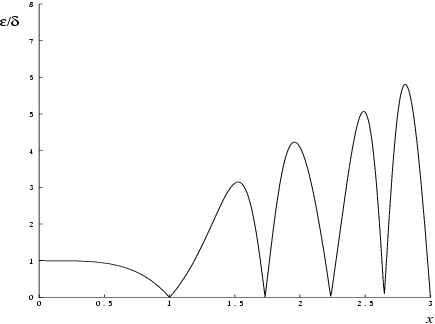NAG Library Routine Document
s20arf
(fresnel_c_vector)
1
Purpose
s20arf returns an array of values for the Fresnel integral .
2
Specification
Fortran Interface
| Integer, Intent (In) | :: |
n | | Integer, Intent (Inout) | :: |
ifail | | Real (Kind=nag_wp), Intent (In) | :: |
x(n) | | Real (Kind=nag_wp), Intent (Out) | :: |
f(n) |
|
C Header Interface
|
#include nagmk26.h
| void |
s20arf_ (
const Integer *n,
const double x[],
double f[],
Integer *ifail) |
|
3
Description
s20arf evaluates an approximation to the Fresnel integral
for an array of arguments
, for
.
Note: , so the approximation need only consider .
The routine is based on three Chebyshev expansions:
For
,
For
,
where
,
and ,
with .
For small , . This approximation is used when is sufficiently small for the result to be correct to machine precision.
For large , and . Therefore for moderately large , when is negligible compared with , the second term in the approximation for may be dropped. For very large , when becomes negligible, . However there will be considerable difficulties in calculating accurately before this final limiting value can be used. Since is periodic, its value is essentially determined by the fractional part of . If , where is an integer and , then depends on and on modulo . By exploiting this fact, it is possible to retain some significance in the calculation of either all the way to the very large limit, or at least until the integer part of is equal to the maximum integer allowed on the machine.
4
References
Abramowitz M and Stegun I A (1972) Handbook of Mathematical Functions (3rd Edition) Dover Publications
5
Arguments
- 1: – IntegerInput
-
On entry: , the number of points.
Constraint:
.
- 2: – Real (Kind=nag_wp) arrayInput
-
On entry: the argument of the function, for .
- 3: – Real (Kind=nag_wp) arrayOutput
-
On exit: , the function values.
- 4: – IntegerInput/Output
-
On entry:
ifail must be set to
,
. If you are unfamiliar with this argument you should refer to
Section 3.4 in How to Use the NAG Library and its Documentation for details.
For environments where it might be inappropriate to halt program execution when an error is detected, the value
is recommended. If the output of error messages is undesirable, then the value
is recommended. Otherwise, if you are not familiar with this argument, the recommended value is
.
When the value is used it is essential to test the value of ifail on exit.
On exit:
unless the routine detects an error or a warning has been flagged (see
Section 6).
6
Error Indicators and Warnings
If on entry
or
, explanatory error messages are output on the current error message unit (as defined by
x04aaf).
Errors or warnings detected by the routine:
-
On entry, .
Constraint: .
An unexpected error has been triggered by this routine. Please
contact
NAG.
See
Section 3.9 in How to Use the NAG Library and its Documentation for further information.
Your licence key may have expired or may not have been installed correctly.
See
Section 3.8 in How to Use the NAG Library and its Documentation for further information.
Dynamic memory allocation failed.
See
Section 3.7 in How to Use the NAG Library and its Documentation for further information.
7
Accuracy
Let and be the relative errors in the argument and result respectively.
If
is somewhat larger than the
machine precision (i.e if
is due to data errors etc.), then
and
are approximately related by:
Figure 1 shows the behaviour of the error amplification factor
.
However, if is of the same order as the machine precision, then rounding errors could make slightly larger than the above relation predicts.
For small , and there is no amplification of relative error.
For moderately large values of
,
and the result will be subject to increasingly large amplification of errors. However the above relation breaks down for large values of
(i.e., when
is of the order of the
machine precision); in this region the relative error in the result is essentially bounded by
.
Hence the effects of error amplification are limited and at worst the relative error loss should not exceed half the possible number of significant figures.
8
Parallelism and Performance
s20arf is not threaded in any implementation.
None.
10
Example
This example reads values of
x from a file, evaluates the function at each value of
and prints the results.
10.1
Program Text
Program Text (s20arfe.f90)
10.2
Program Data
Program Data (s20arfe.d)
10.3
Program Results
Program Results (s20arfe.r)

